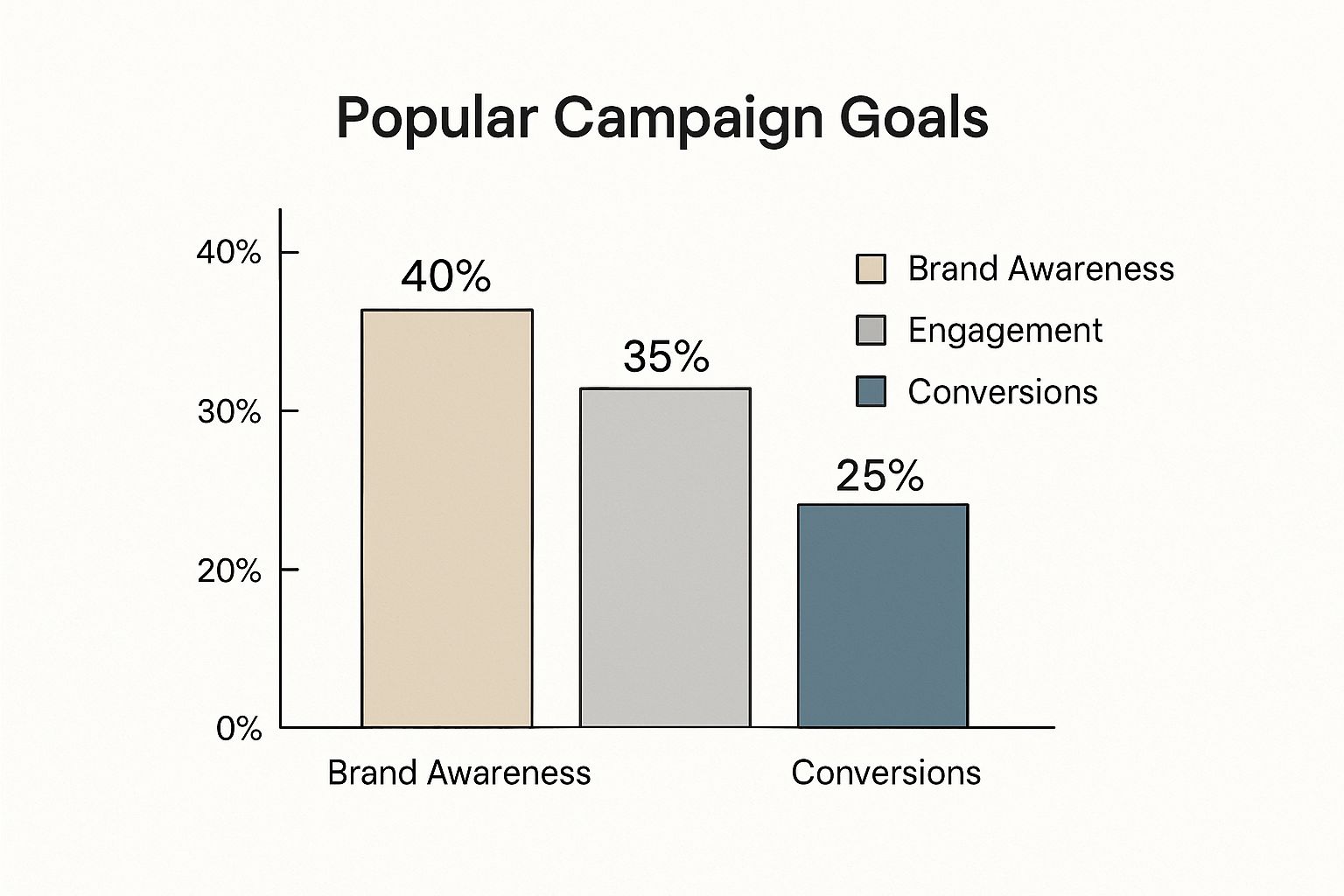
Master Your Influencer Marketing Strategy Today
Published
Navigating the Modern Influencer Landscape
The influencer marketing landscape has changed dramatically. It's no longer just about celebrity endorsements. Now, it's a much more strategic and nuanced approach. Traditional advertising is becoming less effective as consumers grow more discerning and skeptical of overly polished brand messaging. This shift is rooted in a fundamental change in consumer trust, where authentic recommendations from trusted sources carry more weight than ever. Think about it: a celebrity endorsing a product they clearly don't use versus a relatable creator genuinely excited about its benefits. The latter resonates far more deeply, building genuine connection and tangible results.
This change in consumer behavior is driven by several key factors. People look for validation and connection, often turning to their peers and admired figures for guidance on purchases. The rise of social media has created a culture of transparency and authenticity, where consumers value genuine experiences and opinions over carefully constructed marketing campaigns. This means brands must adapt their influencer marketing strategies to embrace these shifts.
Influencer marketing has exploded in recent years, demonstrating its effectiveness. The global influencer marketing platform industry is expected to reach nearly $33 billion by 2025. Over 80% of marketers find influencer marketing highly effective, with a quarter of brands dedicating over 40% of their marketing budget to influencer partnerships. Furthermore, the use of AI in influencer marketing is increasing, with over 73% of marketers believing AI can automate influencer marketing tasks. This highlights the growing importance of influencer marketing within the broader marketing landscape. For a deeper dive into the data, check out these Influencer Marketing Statistics.
Understanding the Influencer Ecosystem
To succeed in this evolving environment, brands must understand the different types of influencers and their strengths. Micro-influencers, with their smaller but highly engaged audiences, often deliver impressive results for niche products and services. Macro-influencers, on the other hand, offer broader reach and increased brand awareness. Successfully navigating this landscape requires a strategic mix of both, carefully aligning influencer selection with specific campaign goals.
Building Authentic Partnerships
The core of successful influencer marketing lies in building genuine, long-term relationships with creators. Instead of treating influencers as just advertising channels, brands should prioritize genuine collaborations that benefit both parties. This means understanding the influencer's values, audience, and content style to ensure a natural integration of the brand message. For more information on influencer marketing concepts and trends, see this guide: Influencer Marketing. By focusing on long-term partnerships rather than transactional engagements, brands can unlock the true potential of influencer marketing and cultivate deeper connections with their target audiences.
Finding Your Perfect Creator Partners
Finding the right influencers is crucial for a successful influencer marketing strategy. It's not just about follower counts; it's about finding creators who genuinely align with your brand values and resonate with your target audience. This means looking beyond vanity metrics like follower count and focusing on factors that indicate true influence, such as how well the influencer's audience aligns with your ideal customer profile. This targeted approach ensures your message reaches the right people, maximizing campaign impact.
Evaluating Influencer Impact
How can you truly gauge an influencer's impact? One effective method is analyzing engagement quality. Look for genuine interactions and conversations within their community. Do their followers actively participate in discussions and respond to calls to action? High engagement rates often signify a strong, loyal following, indicating the influencer holds genuine sway over their audience. This can translate into higher conversion rates for your brand.
Additionally, consider the authenticity of the influencer's content. Do they genuinely believe in the products or services they promote? Authenticity builds trust, and trust drives conversions.

The infographic above visualizes popular campaign goals in influencer marketing. Brand awareness (40%) and engagement (35%) are key drivers, followed by conversions (25%). This data highlights the importance of aligning your influencer selection with your specific campaign objectives.
If your goal is brand awareness, focus on influencers with broad reach. If driving conversions is your priority, prioritize influencers with high engagement and a proven track record of driving sales.
Building Lasting Relationships
Many leading brands are shifting away from transactional influencer relationships toward building long-term partnerships. This approach fosters a deeper understanding between the brand and the influencer, leading to more authentic and effective campaigns. This collaborative approach allows for ongoing content creation, deeper integration of the brand message, and stronger connections with the influencer’s audience.
Long-term partnerships often lead to better cost efficiency compared to one-off campaigns. The influencer landscape is constantly evolving. For example, nano-influencers, influential within niche communities, now represent 75.9% of Instagram's influencer base.
To help understand the various types of influencers and their potential impact, take a look at the table below:
Influencer Types: Comparing Reach, Engagement & Cost
A comprehensive comparison of different influencer categories to help brands choose the most appropriate partners based on campaign goals and budget.
| Influencer Type | Follower Range | Typical Engagement Rate | Average Cost Per Post | Best Use Cases |
|---|---|---|---|---|
| Nano | 1,000 - 10,000 | 5% - 10% | $10 - $100 | Building community, niche targeting, product seeding |
| Micro | 10,000 - 50,000 | 2% - 5% | $100 - $500 | Targeted campaigns, product launches, building brand awareness |
| Mid-Tier | 50,000 - 500,000 | 1% - 3% | $500 - $5,000 | Wider reach, larger campaigns, driving traffic |
| Macro | 500,000 - 1 million | <1% - 2% | $5,000 - $10,000 | Mass awareness, large-scale campaigns, celebrity endorsements |
| Mega | 1 million+ | <1% | $10,000+ | Global campaigns, maximum reach, partnerships with highly established figures |
This table provides a general overview. Actual costs and engagement rates can vary depending on the specific influencer and industry. Furthermore, the use of AI in identifying suitable influencers is rising, with 55.8% of marketers showing interest. Find more detailed statistics here.
By embracing a more strategic, data-driven approach, brands can effectively navigate this complex landscape and build highly successful influencer marketing campaigns.
Designing Campaigns That Drive Real Results

Even with the ideal influencer partners, a campaign lacking clearly defined objectives will likely fall short. This underscores the importance of aligning your influencer marketing strategy with specific, measurable business goals, rather than pursuing superficial metrics. Instead of concentrating solely on likes and follows, consider the broader impact of your campaign on overall business objectives. This crucial shift from output to outcomes is key to maximizing ROI.
Setting Meaningful KPIs
How do successful brands evaluate their influencer marketing performance? They establish Key Performance Indicators (KPIs) that directly link creator content to tangible business results. For instance, if your aim is to boost brand awareness, track metrics such as reach, impressions, and share of voice.
If, however, your primary objective is driving sales, concentrate on KPIs like website traffic, conversions, and discount code redemptions. By aligning KPIs with campaign goals, you can effectively assess the impact of your influencer collaborations. For more detailed strategies, explore our guide on How to master influencer marketing best practices.
Tracking and Measurement
Developing comprehensive tracking mechanisms is vital for capturing both immediate and long-term value. This involves utilizing trackable links, unique discount codes, and dedicated landing pages to precisely measure influencer-driven traffic and conversions.
Furthermore, consider monitoring social listening metrics to gauge the campaign's influence on brand perception and sentiment. This comprehensive approach provides a holistic view of campaign performance.
Structuring Campaigns for Different Objectives
Varying campaign objectives necessitate different approaches. To identify and connect with the right influencers for your campaigns, understanding effective engagement strategies is crucial. Learn more about connecting with influencers.
For brand awareness campaigns, prioritize influencers with extensive reach and high engagement. Collaborate on content that effectively communicates your brand values and narrative to a broader audience. For conversion-focused campaigns, partner with influencers with a demonstrated history of driving sales within your target demographic. Utilize clear calls to action and trackable links to measure the direct impact on sales.
For example, a skincare company launching a new product could partner with beauty influencers to generate sponsored posts and reviews. By providing influencers with unique discount codes, the brand can directly monitor conversions stemming from the campaign. They can also track social media discussions to evaluate the overall reception of the new product.
By prioritizing measurable outcomes and aligning your influencer marketing strategy with your broader business goals, you can ensure your campaigns deliver substantial, tangible value.
Crafting Briefs That Inspire Great Content

The quality of your brief often makes the difference between mediocre and exceptional influencer-generated content. A well-crafted brief offers clear direction while respecting the creator's expertise. This balance is fundamental to an effective influencer marketing strategy and unlocks authentic and engaging content.
Elements of a Comprehensive Creative Brief
A strong brief needs to cover key aspects of the campaign. This ensures alignment and maximizes the potential for successful collaboration.
- Campaign Goals: Clearly state your objectives. Are you aiming for brand awareness, increased engagement, or driving conversions?
- Target Audience: Describe the specific demographic the influencer should target. This allows them to tailor their content effectively.
- Key Messages: Define the core information you want to communicate. Provide guidance without restricting the creator's authentic voice.
- Deliverables: Specify the expected outputs. This might include the number of posts, videos, or stories required.
- Timeline: Set clear deadlines for each stage. This promotes efficiency and ensures timely delivery of the content.
- Budget: Be transparent about the allocated budget. This sets realistic expectations from the start.
Balancing Guidelines and Creative Freedom
Leading brands recognize the importance of giving creators creative freedom. While guidelines are important, they should inspire, not restrict. Instead of dictating specific wording, suggest talking points. Encourage influencers to adapt these points to their unique style. This approach fosters genuine endorsement and leads to more authentic content that resonates with their audience.
Addressing Common Friction Points
Miscommunication can occur during the briefing process. To minimize this, establish clear communication channels. Encourage open dialogue between the brand and the influencer. Schedule regular check-in meetings to discuss progress, answer questions, and maintain alignment. This proactive approach fosters collaboration and resolves potential issues early on.
By creating a comprehensive and inspiring brief, and by fostering open communication, brands empower influencers to create exceptional content. This collaborative approach helps achieve campaign objectives and enhances the overall influencer marketing strategy, ensuring a mutually beneficial partnership for both parties.
Investing Strategically in Creator Partnerships
Building a successful influencer marketing strategy takes more than just a glance at follower counts. It requires a deep understanding of influencer compensation, budgeting, and nurturing long-term relationships. This involves careful consideration of various compensation models, aligning budget frameworks with specific campaign goals, and negotiating terms that benefit both brand and influencer.
Understanding Influencer Compensation Models
Several methods exist for compensating influencers, each with its own set of pros and cons. Flat fee arrangements offer clarity and predictability, making them well-suited for projects with clearly defined deliverables. However, flat fees may not incentivize performance beyond the initial agreement.
Performance-based models, such as cost-per-acquisition (CPA) or cost-per-click (CPC), link compensation directly to campaign results. While highly effective for driving conversions, these models require reliable tracking mechanisms.
Hybrid models blend elements of both, providing a base fee supplemented by performance bonuses. This approach balances predictability with performance incentives, fostering a collaborative partnership.
Developing Budget Frameworks
A well-structured budget is essential for a successful influencer marketing strategy. Begin by aligning your budget with your campaign goals. Are you focused on broad reach and awareness, or is your primary objective driving conversions?
Consider diversifying your investment across different influencer tiers. A mix of macro-influencers for reach and micro-influencers for targeted engagement can optimize your budget allocation. To help visualize this process, let's look at a sample framework. The table below illustrates a strategic breakdown of how brands should distribute their influencer marketing budget based on campaign objectives and platform priorities.
To understand this budget allocation further, let's examine an example budget allocation framework.
| Budget Component | Percentage Allocation | Considerations | Scaling Tips |
|---|---|---|---|
| Influencer Fees | 50% - 70% | Influencer tier, content format, campaign length | Negotiate long-term contracts, explore tiered pricing |
| Content Production | 10% - 20% | Photo/video shoots, editing, graphic design | Build in-house content capabilities, leverage user-generated content |
| Platform & Tool Costs | 5% - 10% | Influencer marketing platforms, analytics tools | Explore free or low-cost alternatives, optimize tool usage |
| Contingency Buffer | 5% - 10% | Unexpected costs, campaign adjustments | Monitor campaign performance closely, adjust budget as needed |
This framework provides a general guideline. The actual percentage allocation for each component may vary based on the specific requirements of each campaign.
Negotiating Fair Terms and Building Long-Term Relationships
Negotiating fair terms is paramount for establishing strong relationships with creators. Transparency about your budget and expectations, combined with a collaborative approach, helps achieve mutually beneficial agreements.
Instead of focusing solely on one-off campaigns, prioritize building ongoing relationships with key influencers. This approach fosters trust, deepens collaboration, and allows for more integrated and impactful campaigns over time. This long-term approach can also lead to cost efficiencies and stronger brand loyalty within the influencer's community.
By understanding influencer compensation models, developing smart budget frameworks, and nurturing long-term relationships, brands can maximize the impact of their influencer marketing investments. This strategic approach not only drives tangible results but also contributes significantly to achieving overall business objectives.
Measuring What Actually Matters

Savvy brands recognize that a successful influencer marketing strategy goes beyond vanity metrics like likes and comments. Instead, they prioritize measuring the real impact by linking creator content directly to business outcomes. This involves diverse methods and tools to track performance across the entire customer journey.
Connecting Content to Business Outcomes
How can you demonstrate the return on investment (ROI) of your influencer marketing activities? The answer lies in establishing a clear connection between influencer-generated content and tangible business results.
For instance, if your objective is to boost sales, track conversions stemming from specific influencer campaigns. Practical tools for this include unique discount codes, trackable links, or dedicated landing pages. This data offers concrete proof of the influencer's contribution to sales growth.
Furthermore, remember the long-term value of influencer marketing. While immediate conversions are crucial, influencers also cultivate brand awareness and nurture customer loyalty over time. These less tangible benefits contribute significantly to sustained business growth.
Advanced Attribution Models
To precisely measure the impact of influencer marketing, brands are increasingly embracing advanced attribution models. These models go beyond attributing a conversion solely to the last click. Instead, they distribute credit across multiple touchpoints throughout the customer journey.
Consider a customer who discovers a product through an influencer's post, later visits the brand's website via a paid ad, and finally completes a purchase a week later after an email reminder. An advanced attribution model would allocate credit to each of these interactions, providing a more comprehensive understanding of the influencer's role in the final conversion. This enables brands to evaluate the full effectiveness of their influencer marketing strategies.
Tracking Performance Across the Customer Journey
Measuring influencer marketing success involves tracking performance throughout the entire customer journey, from initial awareness to final conversion and beyond. You might be interested in: How to master Influencer Marketing KPIs. Brand awareness can be gauged by monitoring reach, impressions, and mentions. Engagement is assessed through likes, comments, shares, and saves.
Further down the funnel, metrics like website traffic, conversions, and customer lifetime value become critical. This holistic approach provides a complete view of campaign performance. Combining quantitative data with qualitative insights, like sentiment analysis and brand perception, offers even deeper understanding. This data-driven approach allows brands to optimize their influencer marketing strategies, maximize ROI, and continually refine their approach.
Evolving Your Influencer Strategy Over Time
A successful influencer marketing strategy isn't a set-it-and-forget-it endeavor. It requires ongoing adaptation and refinement. Just like the dynamic nature of the digital realm, your approach should evolve based on performance data, emerging trends, and market shifts. This involves regular post-campaign analysis, extracting valuable insights, and applying these learnings to future campaigns. Think of it as a continuous feedback loop, constantly informing and enhancing your strategy.
Post-Campaign Analysis: Extracting Actionable Insights
After each campaign concludes, a thorough analysis is essential. This goes beyond simply looking at surface-level metrics like likes and shares. You need to delve deeper into the data.
Which content truly resonated with the audience? What were the primary drivers of conversions? Were there any surprising results? By understanding what was effective and what wasn't, you can refine your strategy for future success. This data-driven approach is paramount for ongoing improvement.
For instance, if a specific type of content consistently outperforms others, consider integrating similar formats into upcoming campaigns. If certain influencers generate significantly higher engagement, prioritize fostering stronger, long-term collaborations with them. This strategic allocation of resources maximizes your return on investment.
Testing New Platforms and Formats
While maintaining a core strategy is important, remaining adaptable and exploring new opportunities is also crucial. The digital world is in constant flux, with new platforms and content formats emerging regularly. Consider experimenting with up-and-coming platforms like TikTok or delving into new content formats like short-form video or live streams. You might find this resource helpful: How to master emerging trends in influencer marketing.
Don't abandon proven strategies completely. Instead, strike a balance. Test new avenues while retaining the foundation of what's already working. This controlled experimentation helps you pinpoint new growth opportunities while minimizing potential risks.
Adapting to Emerging Trends
The creator economy is a vibrant and evolving landscape. Staying informed about emerging trends is vital for sustained success in influencer marketing strategy. This involves keeping track of shifts in consumer behavior, following industry news, and participating in relevant conferences or webinars.
By understanding these evolving trends, you can proactively adjust your strategy. This forward-thinking approach enables you to stay ahead of the curve and maintain a competitive edge. This continuous evolution ensures your influencer marketing program remains effective, adaptable, and aligned with your overall business goals.
Ready to advance your influencer marketing career? Explore exciting opportunities and connect with leading brands at Influencer Marketing Jobs.